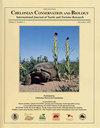Orientation in Five Species of Hatchling River Turtles Dispersing from Experimental Nests
IF 0.8
4区 生物学
Q3 ZOOLOGY
引用次数: 4
Abstract
Abstract Hatchling river turtles (Smooth Softshell Turtles, Apalone mutica; Spiny Softshell Turtles, Apalone spinifera; Northern Map Turtles, Graptemys geographica; False Map Turtles, Graptemys pseudogeographica; and Ouachita Map Turtles, Graptemys ouachitensis) were released in a variety of settings to help place orientation and dispersal from nests in the context of nest site selection by females and juvenile recruitment habitat. Visual cues associated with near open or far dark horizons were the primary environmental cues used during initial orientation and dispersal of the hatchling river turtles. On a river beach, hatchlings of both species of Softshell Turtles dispersed toward the open horizon of the nearby river. In contrast, hatchlings of all 3 species of Map Turtles on the same beach dispersed toward the near dark horizons of a forest that led them away from the river. Hatchling Map Turtles of all 3 species released in autumn and Northern Map Turtles also released in spring at a field arena dispersed toward near dark horizons of pine (Pinus spp.) and deciduous trees to the north and south of the arena (directions that were parallel to the Mississippi River). At a site in upland prairie habitat with no nearby wetlands, hatchlings of all 3 species of Map Turtles dispersed to the north toward near dark horizons of an oak (Quercus spp.) forest rather than toward more distant dark horizons of mixed oak and pine trees. At a lowland prairie site where no near dark horizon was visible, Northern Map Turtles dispersed toward 2 far dark horizons that were ∼ 230 m to the north (a pond surrounded with trees) and to the south (an area of large deciduous trees at the west end of a windrow of pine trees), but not toward the large riparian wetland 280 m to the west. The bimodal dispersal pattern toward 2 equidistant dark horizons within 230 m but not toward the riparian area 280 m to the west suggests that the perception distance for hatchling Northern Map Turtles is between 230 and 280 m. Dispersal of a combined sample of naïve hatchling False Map and Ouachita Map Turtles released in a mature corn field was not different from random, but the directions taken by the majority of hatchlings were to the north and south across corn rows that may be the closest match to dark horizons used for dispersal in typical habitats.五种河龟幼龟从实验巢中分散的定位
摘要河龟(Smooth Softshell turtles, Apalone mutica;有刺的软壳龟,Apalone spinifera;Northern Map Turtles, Graptemys geographys;伪地图龟,伪地理;在不同的环境下释放瓦希托地图龟(Graptemys ouachitensis),以帮助雌性和幼龟在筑巢地点选择和招募栖息地的背景下定位和分散巢穴。与近开放或远黑暗视野相关的视觉线索是河龟幼龟初始定位和扩散过程中使用的主要环境线索。在河滩上,两种软壳龟的幼仔分散到附近河流的开阔地平线上。相比之下,同一海滩上所有三种地图龟的幼龟都分散在森林的近黑暗地平线上,这使它们远离河流。在秋季释放的所有3种地图龟的幼龟和春季释放的北部地图龟也在野外竞技场中分散到竞技场北部和南部的松树(Pinus spp.)和落叶树的黑暗地平线附近(方向与密西西比河平行)。在一个附近没有湿地的高地草原栖息地,所有3种地图龟的幼龟都向北散布在橡树林的黑暗视野附近,而不是向更远的橡树和松树混合的黑暗视野分散。在一个没有近黑暗地平线的低地草原上,北部地图龟向2个较远的黑暗地平线分散,这两个地平线分别位于北部约230米(树木环绕的池塘)和南部(松树窗西端的大型落叶树区域),但没有向西部280米的大型河岸湿地分散。在230 m以内向2个等距暗层扩散的双峰分布模式,在向西280 m的河岸区不扩散,说明北图龟孵化的感知距离在230 ~ 280 m之间。在成熟的玉米地里放生的naïve幼龟假图龟和瓦奇塔幼龟的组合样本的扩散与随机分布没有什么不同,但大多数幼龟的方向是穿过玉米垄向北和向南,这可能是最接近典型栖息地中用于扩散的黑暗地平线的方向。
本文章由计算机程序翻译,如有差异,请以英文原文为准。
求助全文
约1分钟内获得全文
求助全文
来源期刊
CiteScore
1.70
自引率
14.30%
发文量
17
审稿时长
>12 weeks
期刊介绍:
Chelonian Conservation and Biology is a biannual peer-reviewed journal of cosmopolitan and broad-based coverage of all aspects of conservation and biology of all chelonians, including freshwater turtles, marine turtles, and tortoises. Manuscripts may cover any aspects of turtle and tortoise research, with a preference for conservation or biology. Manuscripts dealing with conservation biology, systematic relationships, chelonian diversity, geographic distribution, natural history, ecology, reproduction, morphology and natural variation, population status, husbandry, community conservation initiatives, and human exploitation or conservation management issues are of special interest.

 求助内容:
求助内容: 应助结果提醒方式:
应助结果提醒方式:


